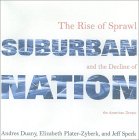
****Suburban Nation
The Rise of Sprawl and the Decline of the American Dream
by Andres Duany, Elizabeth Plater-Zyberk, and Jeff Speck
Reviewed December 6, 2001.
A Sonderbooks' Best Book of 2001
North Point Press (a division of Farrar, Straus, and Giroux),
2000. 289 pages.
Available at Sembach Library, regular collection, 307.76 DUA.
I’m excited about this book. Ever since I moved to Germany,
I noticed that the German villages are a much more pleasant place to
live than suburban America. It seemed to go deeper than the presence
of deer out my window. The separation of all human buildings into
villages means that we drive through lovely forests and fields to get
to work. When I visited America in 1999, the width of the roads
seemed almost obscene. Something was disturbing about all the strip
malls and traffic lights.
Finally, someone has written a book about precisely why the suburban
sprawl does not work out to as nice a place to live.
A wonderful part of the book is that the authors do not believe
that America has to stay this way. They say that every fifty or
sixty years, America reinvents itself. They claim that suburban
sprawl is a North American phenomenon that began after WWII. They
present ways that this can be changed.
Please don’t rely on my summary alone. This book is well
worth reading. I intend to buy a copy myself to refer back to.
It explains what’s wrong with sprawl and how it can be fixed. I’m
not sure I wouldn’t be so completely enthusiastic about the book if I couldn’t
so easily see for myself examples both positive and negative of what the
authors are talking about.
One of their main points is that we have been building for cars,
not for people. If you put pedestrians and inhabitants at the focus
of a plan, you can build something more livable for everyone.
One of the main components of sprawl is single-use zoning.
You have housing separate from businesses separate from shopping, and
so on. If, instead, you build neighborhoods with places people
want to walk to within a five-minute radius, you will reduce the need for
cars as well as creating a more pleasant place to live. Of course,
we see this modelled all around us in German villages.
There are many, many interesting repercussions of this idea presented
in the book. One is that when you must drive everywhere you want
to go, children and the elderly who cannot drive become dependent on
others. In a neighborhood setting, the elderly can walk where
they want to go and stay in their own homes even when they can no longer
drive. This resonated with me when I think of all the elderly Germans
I see walking in the villages.
In college, for a couple of summers I lived down the street from
my university, and walked onto campus along Biola Avenue, a typical suburban
street. Although there were nice homes along it, this walk was
never as nice as a walk along my parents’ street. This book offers
many reasons why. Although both streets are ridiculously wide for
a residential street, my parents’ street (built probably 60 years earlier
than Biola Avenue) is lined with trees. The authors say that this
gives pedestrians an enclosed feeling, and a feeling of protection from
cars, making walking much more pleasant.
The authors also explain why wide streets sometimes cause accidents.
People tend to drive at speeds at which they feel safe, never mind the
posted speed limit. Again, I can think of Biola Avenue’s silly 30
mph speed limit as an example. It was tremendously difficult to
keep down to that speed on such a wide road. All that land paved over,
sacrificed to automobiles, does nothing to make the environment more livable.
Again, I can see the contrast in Germany. Although I have to say
that perhaps Germans take the idea of narrow roads to the opposite extreme,
now that I’m used to it, I appreciate the fact that so much less land is
paved.
Of course, the Germans don’t always get it right. Recently,
a new store was built here in Alsenborn with a big huge parking lot
in front of it, exactly like the American model the authors speak against.
When the store is fronted by parking, you know that it wasn’t built
for pedestrians, but for motorists. Still, enough shops are left
for walking to, I hope that things will never reach the extreme they’ve
come to in America. I think I’ll walk to the bakery and think about
it!
These are only a few of the ideas expressed in this book.
This is a book I wish everyone would read. Let’s make America a
pleasant place to live again! The authors present numerous examples,
statistics and pictures supporting their case. They claim that
laws are what produced suburban sprawl, and those laws need to change.
I hope that they will gain a wide audience.
Copyright © 2003 Sondra Eklund.
All rights reserved.
-top
of page-